Scattered yet striking
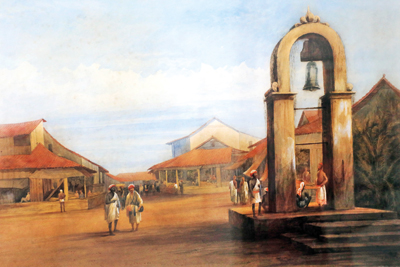
Andrew Nicholl’s watercolour of Cayman’s Gate
In the Colombo National Museum, the colonial heritage of Lanka seems often underplayed. There are galleries sumptuous and magnificent dedicated to the classical eras of Anuradhapura, Polonnaruwa and the later isthmus kingdoms leading to the final, Kandyan feudal era, but the four and a half centuries from 1505 to 1948 remain dim lit and ill defined.
This is surprising given that the museum was built in 1877, in the height of Queen Victoria – Empress of India’s glory. The largest museum in the country, it is maintained by the Department of National Museums.
Built in the Italianate style, the banyan-shaded Colombo Museum located in a prime spot on Sir Marcus Fernando Mawatha, Colombo 7 is an imposing structure.
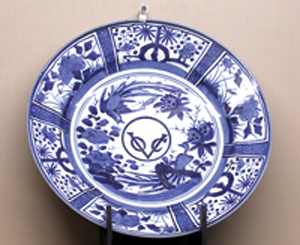
Dutch Plate
One has to cut across floors to appreciate the colonial collection in the museum which if scattered is nevertheless striking.
Begin with the gold and scarlet Kandyan throne which comes under the ‘colonial’ badge because it was a gift from the Dutch Governor Thomas van Rhee to Vimaladharmasurya I which then enthroned six monarchs. Rich carvings of divinities and the sun and two lions are a feature to note here.
The sword and rapier – those emissaries of steel used by the Portuguese, the Dutch and British are displayed- the Dutch swords with simple hilts giving place to the British pommeled ones made to be brandished from a horse.
Coins begin with the crude circular ones from the Portuguese times: a gold coin with the form of S. Thomas on the obverse and date on the reverse, and three silver coins called the Malacca, the Gridiron and the Saint.
Dutch coinage in Ceylon, easily spotted because of the VOC emblem – are well represented.
British coins were first minted in 1796 in the maritime regions. There is a fine collection of ‘star pagodas’ and 1/96 and 1/48 Rupee copper coins. From 1801 to 1804 Stuiver 1/2 and 1/4 coins came to be used.
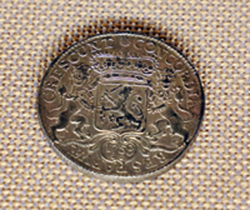
British coin
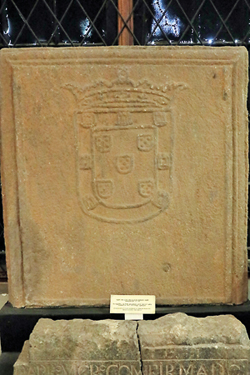
Dutch coat of arms above old Menikkadavara fort, Kegalle
During 1803, an 1816 Pataga 1 and 1/2 were used. In these coins, a figure of an elephant with the year of issue and the legend “Ceylon Government’ appeared on the obverse.
The use of pounds, shillings and pences was commenced on March 23, 1825.
About 1830 two types known as Farthings of copper and silver came to be used. From December 14,1833, Indian Rupees minted by the British came into use. From January 1,1872, the Rupees and cents system was commenced while copper issues of 5 cents, 1 cent, 1/2 cent and still later silver 50, 25 and 10 cent coins were used.
Also housed in the Museum are the Andrew Nicholl paintings from the Irish artist’s five week sketching tour in Ceylon – such exotic sights as a wide, palm-fringed harbour with sailing craft and ruins of Buddhist sites shrouded in jungle.
Arguably the most dramatic, heart-rending artefacts are the jackets worn by King Sri Wickrama Rajasinha and his chief consort, still marked with their royal blood, after the English rank and file caught them hiding in a chieftain’s house.
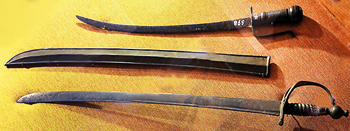
Swords of the Dutch era
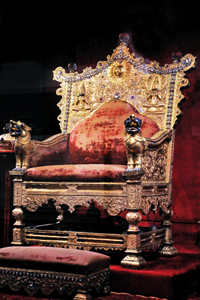
The Kandyan throne given by Governor van Rhee to King Vimaladharmasurya and used by six Kandy kings
A collection of Portuguese and Dutch inscriptions rather like honey coloured loafs of bread with those large Roman letters and numerals handsomely worked; tombstones as well as other carvings also beckons the visitor, as does a huge rock carved with Dutch arms that used to hang over the entrance to the Menikkadavara Fort.
Delftware from Holland and pottery in blue or all the colours of the Far Orient are also displayed.
Finally, housed without in those spacious verandahs outside
are cannons from the Dutch and Portuguese times.
| A stately mansion | |
| Reminding one of grand English stately mansions, the museum is a delight because of its airy colonial halls and large verandahs and passages, redolent of earlier, more leisured times- a feeling added to by the sprawling grounds.Commissioned by the Governor Sir Henry William Gregory, it was designed by J. G. Smither, Public Works Department architect and built by Arasi Marikar Wapchie Marikar (1829–1925) who also gave Colombo its familiar contours with other landmark buildings – the General Post Office, Colombo Customs building, the old Town Hall in Pettah and the Galle Face Hotel. |
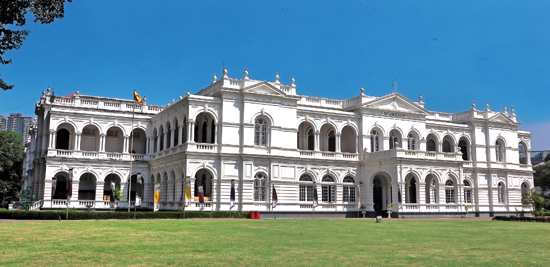
Grand facade: A front view of the Colombo Museum. Pix by M.A. Pushpa Kumara
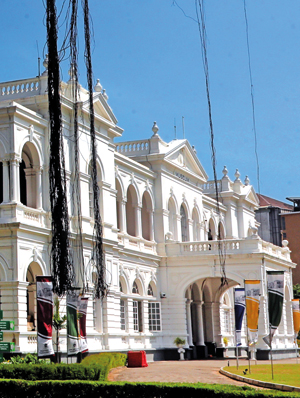
Searching for an ideal partner? Find your soul mate on Hitad.lk, Sri Lanka's favourite marriage proposals page. With Hitad.lk matrimonial advertisements you have access to thousands of ads from potential suitors who are looking for someone just like you.


